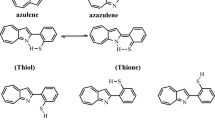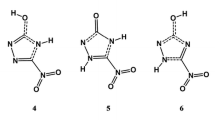Abstract
Density functional theory (DFT) calculations show that in vacuum such α-diketone as 1-(pyridin-2-yl)-4-(quinolin-2-yl)butane-2,3-dione is much less stable than its enolimine–enaminone ((1Z,3Z)-3-hydroxy-4-(pyridin-2-yl)-1-(quinolin-2(1H)-ylidene)but-3-en-2-one) and dienaminone tautomers ((1Z,3Z)-1-(pyridin-2-yl)-4-(quinolin-2-yl)buta-1,3-diene-2,3-diol). Other its tautomers (multiple basic and acidic centers in their molecules enable multiple proton transfer to take place) are even more labile. Strength of the intramolecular hydrogen bonds and aromatic character of the (quasi)rings [proved by the Harmonic Oscillator Model of Aromaticity (HOMA) index] in their molecules were found to be responsible for the observed tautomeric preferences. Polar and basic solvent disfavors and favors the enolimine and enaminone tautomers, respectively.
Similar content being viewed by others
Avoid common mistakes on your manuscript.
Introduction
To an understanding of the reactions of a potentially tautomeric compound it is fundamental to know which tautomeric form predominates, and further to have information on the degree of predominance or energy difference involved [1]. In literature there are many examples of wrongly recognized tautomeric forms. Thus, in chloroform solution 2-phenacylquinoline is in tautomeric equilibrium with (Z)-1,2-dihydro-2-(benzoylmethylene)quinoline [2], misnamed earlier as (Z)-2-(2-hydroxy-2-phenylvinyl)quinoline [3]. Similarly, in DMSO solution 1-(p-methylphenacyl)isoquinoline equilibrates not with (Z)-1-(2-hydroxy-2-(p-methylphenylvinyl)isoquinoline [4] but with (Z)-1,2-dihydro-1-(p-methylbenzoylmethylene)isoquinoline [5].
Some heterocyclic α-diketones can be transformed into numerous tautomeric forms but only some of them have a chance to be present in the tautomeric mixture. NMR (chloroform solution), X-ray (crystal) and ab initio studies (vacuum and chloroform solution) show that (1Z,3Z)-1,4-di(pyridin-2-yl)but-1,3-diene-2,3-diol and (3Z)-3-hydroxy-1,4-di(quinolin-2-yl)-but-3-en-2-one are always more stable tautomeric forms than 1,4-di(pyridin-2-yl)butane-2,3-dione and 1,4-di(quinolin-2-yl)butane-2,3-dione molecule, respectively [6, 7]. 1-(Pyridin-2-yl)-4-(quinolin-2-yl)butane-2,3-dione, the relative unsymmetrical α-diketone, is not known but its susceptibility to the prototropic rearrangement seems also very interesting. The density functional theory (DFT) method used by us recently [8, 9] seems worthy to be applied to evaluate stabilities of this compound and its tautomers.
Theoretical approach
Standard B3LYP DFT calculations were carried out using Gaussian software package [10]. The B3LYP approach includes Becke’s three parameter non-local hybrid exchange potential [11] and the non-local correlation functional of Lee et al. [12]. The 6-31+G(d,p) basis set with polarization functions on all atoms and diffuse functions on heavy atoms was used. Computations were performed for the isolated molecules (no intermolecular interactions were considered) and in the chloroform and DMSO solutions (using polarized continuum model PCM [13, 14]). The vibrational frequencies were obtained at the same level to make sure that geometry is in minimum (no imaginary frequencies).
Results and discussion
There are multiple basic (two nitrogen and two oxygen atoms) and acidic (four methylene hydrogen atoms) centers in the molecule of 1-(pyridin-2-yl)-4-(quinolin-2-yl)butane-2,3-dione. As a consequence, this diketone may equilibrate with its numerous tautomers. Their formulas as well as numbering of heavy atoms in the molecule can be seen in Scheme 1. Except some exceptionally unstable rotamers [6, 7], other species of this type are also included there.
All tautomers and rotamers shown in Scheme 1 were subjected to the DFT calculations. Comparison of their energies (Table 1) shows that only OEa and OOa are expected to be present in the tautomeric mixture in vacuum. These results are in agreement with our earlier studies that show that the respective dienol and enol/enaminone forms are more stable than 1,4-bis(pyridin-2-yl)butane-2,3-dione and 1,4-bis(quinolin-2-yl)butane-2,3-dione, respectively [6, 7]. Solvent, especially this more polar and of more basic properties (DMSO) disfavors the enolimine tautomers. Thus, OOa is present in vacuum only (Table 1). Moreover, contribution of OEa is highest in vacuum and lowest in DMSO. On the other hand, enaminone tautomers are favored in this solvent. Amount of EEa in chloroform and DMSO solutions is equal to 40 and 84%, respectively. Some solute–solvent interactions of the hydrogen bond character are probably responsible for increased contribution of this tautomer. The calculated dipole moments of the respective tautomers/rotamers (Table 1) are not simply related to their relative proportions.
Relatively high contribution of the dienol tautomer OOa (Table 1) enables intramolecular proton transfer in OEa to take place (Scheme 2). Such tautomeric equilibria are not unique [7]. Calculations show that in vacuum the energies of 14.76 and 18.52 kJ/mol are required for OEa to be transformed into OOa and EEa, respectively.
Contrary to their diketone tautomer, KKa, (1Z,3Z)-3-hydroxy-4-(pyridin-2-yl)-1-(quinolin-2(1H)-ylidene)but-3-en-2-one, OEa, and (1Z,3Z)-1-(pyridin-2-yl)-4-(quinolin-2-yl)buta-1,3-diene-2,3-diol, OOa, are stabilized by the intramolecular hydrogen bonds. There are two such interactions in each molecule of two most stable tautomers. Since all of them are relatively short, their stabilizing effect is evident. Geometry optimization shows that the tautomers studied are planar. Calculations show that length of the H5···N1 hydrogen bond in OEa decreases when the solvent became more polar (it is longest in vacuum). On other hand, length of the H5–O5 bond changes in the reverse order (Table 2). Thus, high polarity of the solvent favors shifting of the H5 proton toward N1 that finally results in transformation of enolimine into enaminone (Scheme 2). This is in agreement with results of the calculations (Table 1) that show percentage of OEa to be lowest in DMSO.
Except intramolecular hydrogen bonds, aromaticity of the compound is another criterion of its stability [15]. The bond lengths in the tautomeric forms can be used to estimate the geometry-based aromaticity index Harmonic Oscillator Model of Aromaticity (HOMA) [16, 17] defined as
where n represents the total number of bonds in the molecule, α i is a normalization constant (for CC, CO, and CN bonds αCC = 257.7, αCO = 157.38, and αCN = 93.52, respectively). It is fixed to give HOMA = 0 for a model non-aromatic system, e.g., Kekul’e structure of benzene and HOMA = 1 for the system with all bonds equal to the optimal value R opt,i, assumed to be realized for fully aromatic systems. For C–C bonds, R opt,C–C = 138.8 pm, for CN bonds R opt,C–N = 133.4 pm and for C–O is R opt,C–O = 126.5 pm. The higher the HOMA value, the more aromatic is the ring in question, and hence, more delocalized the π electrons of the system.
The calculated values of the index HOMA are presented in Table 3. It is noteworthy that the HOMA values show that (quasi)rings B′, A′, and C in OEa follow the topological phenanthrene-like motif [18, 19] with the empty inner ring A′, fully aromatic outer quasi-ring B′ and ring C. On the other hand, the same rings in OOa tautomer follow the naphthalene-like motif (Scheme 3). The same arrangement of the A and B rings can be seen in the EEa form. Ring A is fully aromatic both in the OEa and OOa molecules. Relatively high HOMA values for the quasi-rings B(′) prove that intramolecular hydrogen bonds in OEa, OOa, and EEa are of Resonance-Assisted Hydrogen Bond (RAHB) type [20–23].

Conclusions
Results of the DFT calculations show that (1Z,3Z)-3-hydroxy-4-(pyridin-2-yl)-1-(quinolin-2(1H)-ylidene)but-3-en-2-one and (1Z,3Z)-1-(pyridin-2-yl)-4-(quinolin-2-yl)buta-1,3-diene-2,3-diol in vacuum are more stable than their other tautomers. Relatively strong intramolecular hydrogen bonds and aromatic character of their molecules is responsible for stability of these species. Basic solvent such as DMSO disfavors the enolimine tautomers. On the other hand, the solute–solvent interactions of the hydrogen bond character can result in increasing of the contribution of enaminone tautomers in solution.
References
Katritzky AR (1965) Chem Ind (London) 331–335
Kolehmainen E, Ośmiałowski B, Krygowski TM, Kauppinen R, Nissinen M, Gawinecki R (2000) J Chem Soc Perkin Trans 2:1259–1266
Konno Sh, Shiraiwa M, Yamanaka H (1981) Chem Pharm Bull 29:3554–3560
Gnichtel H, Möller B (1981) Liebigs Ann Chem 1751–1759
Gawinecki R, Kolehmainen E, Loghmani-Khouzani H, Ośmiałowski B, Lovász T, Rosa P (2006) Eur J Org Chem 2817–2824
Ośmiałowski B, Kolehmainen E, Nissinen M, Krygowski TM, Gawinecki R (2002) J Org Chem 67:3339–3345
Ośmiałowski B, Kolehmainen E, Gawinecki R (2003) Chem Eur J 9:2710–2716
Dobosz R, Gawinecki R (2010) J Mol Struct (Theochem) 940:119–123
Dobosz R, Gawinecki R, Kanabaj A (2010) J Mol Struct (Theochem) 949:57–59
Frisch MJ, Trucks GW, Schlegel HB, Scuseria GE, Robb MA, Cheeseman JR, Montgomery JA Jr, Vreven T, Kudin KN, Burant JC, Millam JM, Iyengar SS, Tomasi J, Barone V, Mennucci B, Cossi M, Scalmani G, Rega N, Petersson GA, Nakatsuji H, Hada M, Ehara M, Toyota K, Fukuda R, Hasegawa J, Ishida M, Nakajima T, Honda Y, Kitao O, Nakai H, Klene M, Li X, Knox JE, Hratchian HP, Cross JB, Bakken V, Adamo C, Jaramillo J, Gomperts R, Stratmann RE, Yazyev O, Austin AJ, Cammi R, Pomelli C, Ochterski JW, Ayala PY, Morokuma K, Voth GA, Salvador P, Dannenberg JJ, Zakrzewski VG, Dapprich S, Daniels AD, Strain MC, Farkas O, Malick DK, Rabuck AD, Raghavachari K, Foresman JB, Ortiz JV, Cui Q, Baboul AG, Clifford S, Cioslowski J, Stefanov BB, Liu G, Liashenko A, Piskorz P, Komaromi I, Martin RL, Fox DJ, Keith T, Al-Laham MA, Peng CY, Nanayakkara A, Challacombe M, Gill PMW, Johnson B, Chen W, Wong MW, Gonzalez C, Pople JA (2004) Gaussian 03 Revision E01 Inc. Gaussian, Wallingford
Becke AD (1993) J Chem Phys 98:1372–1377
Lee C, Yang W, Parr RG (1988) Phys Rev B 37:785–789
Miertus S, Tomasi J (1982) Chem Phys 65:239–245
Miertus S, Scrocco E, Tomasi J (1981) Chem Phys 55:117–129
Raczyńska ED, Kosińska W, Ośmiałowski B, Gawinecki R (2005) Chem Rev 105:3561–3612
Krygowski TM (1993) J Chem Inf Comput Sci 33:70–78
Sobczyk L, Grabowski JS, Krygowski TM (2005) Chem Rev 105:3513–3560
Clar E (1964) Polycyclic hydrocarbons, vols 1 and 2. Academic Press, London
Clar E (1972) Aromatic sextet. Wiley, London
Gilli G, Bellucci F, Ferretti V, Bertolasi V (1989) J Am Chem Soc 111:1023–1028
Bertolasi V, Gilli P, Ferretti V, Gilli G (1991) J Am Chem Soc 113:4917–4925
Gilli P, Bertolasi V, Ferretti V, Gilli G (1994) J Am Chem Soc 116:909–915
Bertolasi V, Gilli P, Ferretti V, Gilli G (1996) Chem Eur J 2:925–934
Acknowledgments
We are very much indebted to the ACK CYFRONET AGH, Kraków (MNiSW/SGI3700/UTPBydg/042/2007) and CI TASK Gdańsk for supply of computer time and providing programs.
Open Access
This article is distributed under the terms of the Creative Commons Attribution Noncommercial License which permits any noncommercial use, distribution, and reproduction in any medium, provided the original author(s) and source are credited.
Author information
Authors and Affiliations
Corresponding author
Electronic supplementary material
Below is the link to the electronic supplementary material.
Rights and permissions
Open Access This is an open access article distributed under the terms of the Creative Commons Attribution Noncommercial License (https://creativecommons.org/licenses/by-nc/2.0), which permits any noncommercial use, distribution, and reproduction in any medium, provided the original author(s) and source are credited.
About this article
Cite this article
Dobosz, R., Gawinecki, R. & Ośmiałowski, B. DFT studies on tautomeric preferences of 1-(pyridin-2-yl)-4-(quinolin-2-yl)butane-2,3-dione in the gas phase and in solution. Struct Chem 21, 1283–1287 (2010). https://doi.org/10.1007/s11224-010-9674-y
Received:
Accepted:
Published:
Issue Date:
DOI: https://doi.org/10.1007/s11224-010-9674-y







